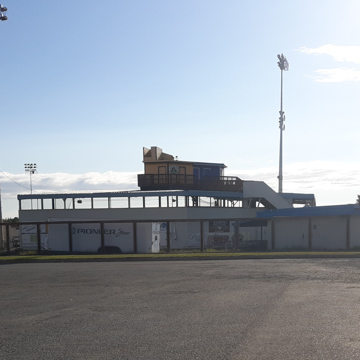Part of the Chester Creek Sports Complex, the city-owned Mulcahy Stadium is located in Midtown Anchorage, just over a mile south of the downtown core. The baseball park is easily accessible from the Seward Highway and offers shared parking with the Sullivan Arena, which is located to its immediate east. The park is named for William Mulcahy, known as the father of Anchorage baseball. This early Anchorage resident and Alaska Railroad employee organized adult leagues and co-founded the city’s first Little League. Mulcahy Stadium is the second Anchorage baseball facility named after him. The first ballpark, which was little more than a diamond cut from the forests, was built in 1916 at West 6th Avenue and C Street. That park, simply called City Ball Park, was rebuilt and expanded in 1949, then renamed for Mulcahy, who was instrumental in its construction and funding. It is now the site of the Anchorage Museum.
The second and current Mulcahy ballpark was completed in early 1962, and the field was seeded that summer, which meant the stadium did not open or host any games until 1963. The seating wraps around the infield at the northeast corner of the lot. A modest press box rises above the covered seating behind home plate. Bullpens are located at the end of the first and third baselines, respectively. Refreshments are available on game days at a stand located behind the home plate boxes. Sweeping views of the Chugach Mountains are visible from the ballfield and right field stands.
The stadium has been renovated several times since its construction. Notably, Mulcahy Stadium underwent an expansion from its original 3,500 seating capacity to its present configuration of over 5,000 seats in 2009. That same year, the infield grass was replaced with artificial FieldTurf. The original scoreboard was replaced with an updated electronic one before the 2007 season, at a cost of $50,000. Despite these modest upgrades, Mulcahy Stadium remains a very small ballpark, particularly in comparison to those in the Major Leagues that have capacities of over 30,000.
Mulcahy Stadium is the home field for the Anchorage Glacier Pilots and Anchorage Bucs of the six-team Alaska Baseball League, a summer league for collegiate players. At one time, the summer league was among the premier leagues of its kind, enticing future stars such as Mark McGuire, Aaron Boone, Dave Winfield, Randy Johnson, and Barry Bonds, to name just a few.
References
Bragg, Beth. “Lights Out.” Anchorage Daily News, June 11, 2009.
Freedman, Lew. Diamonds in the Rough: Baseball Stories from Alaska. Kenmore, WA: Epicenter Press, 2000.
Klott, Kevin. “Mulcahy Younger, Fan Friendly After Facelift.” Anchorage Daily News, June 10, 2007, C1.
Land Design North with USKH and Robert Droll. Chester Creek Sports Complex: Master Plan Update, Existing Conditions Report. Anchorage: Municipality of Anchorage Parks and Recreation Department, January 2006.
“New Delay Expected for Baseball Stadium.” Anchorage Daily Times, September 20, 1961, 2.
“Mulcahy Stadium—Home of the Anchorage Glacier Pilots.” Anchorage Glacier Pilots. www.glacierpilots.com/.

